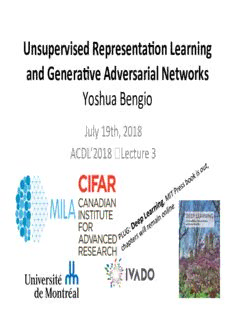
Lecture 3 (Unsupervised Representation Learning and Generative Adversarial Networks) PDF
Preview Lecture 3 (Unsupervised Representation Learning and Generative Adversarial Networks)
Unsupervised Representa/on Learning and Genera/ve Adversarial Networks Yoshua Bengio July 19th, 2018 ACDL’2018 – Lecture 3 Humans outperform machines at unsupervised learning • Humans are very good at unsupervised learning, e.g. a 2 year old knows intuiGve physics • Babies construct an approximate but sufficiently reliable model of physics, how do they manage that? Note that they interact with the world, not just observe it. Invariance and Disentangling • Invariant features • Which invariances? • AlternaGve: learning to disentangle factors • Good disentangling à avoid the curse of dimensionality: Dependencies are “simple” when the data is projected in the right abstract space 3 Domain Adaptation for Sentiment Classification with Deep Learning Disentangling from denoising objective (GlFoigurre 1.oTratns,fe r loBssesoonrthde Ameazosn ben&chma rkBof 4edomnainsg: Kiitchoen(K ), EIlectCronicMs(E), LDVD s(D) and Books(B). All methods are trained on the labeled set of one domain and evaluated on the test sets of the others. SDA sh outperforms all others on 11 out of 12 cases. 2011) • Early deep learning research already is looking for possible disentangling arising from unsupervised learning of representaGons • Experiments on stacked denoising auto-encoders with ReLUs, on BoW text classificaGon • Features tend to specialize to either senGment or domain Figure 2. Left: Transfer ratios on the Amazon benchmark. Both SDA-based systems outperforms the rest even if SDA is better. Right: Proxy A-distances between domains of the Amazon benchmark for the 6 di↵erent pairs. sh Transforming data with SDA increases the proxy A-distance. sh Raw data SDAsh 1100 5 5 ks 400 ks s s sis ta4 150 sis ta4 y y al3 al3 n 55 n a a nt 2 nt 2 me 20 me nti1 nti1 e 6 e S S # # 0 1 0 0 1 2 3 4 5 6 0 1 2 3 4 5 6 # Domain recognition tasks 0 # Domain recognition tasks # Features Figure 3. L1 feature selection on the Amazon benchmark. Both graphs depict the number of tasks of domain recognition (x-axis) and sentiment analysis (y-axis) in which a feature is re-used by L1-classifiers trained on raw features (left) or features transformed by SDA . (right). See Section 4.3 for details. sh Unsupervised Learning of Representations: Simple Auto-Encoders h code= latent features • MLP whose target output = input encoder • ReconstrucGon=decoder(encoder(input)), decoder input x e.g. … … reconstrucGon r(x) • Code = new coordinate system • Encoder and decoder can have more layers • ReconstrucGon can be probability distribuGon 5 Denoising Auto-Encoder (Vincent et al 2008) • Corrupt the input during training only • Train to reconstruct the uncorrupted input KL(reconstruction | raw input) Hidden code (representation) Corrupted input Raw input reconstruction • Encoder & decoder: any parametrizaGon • As good or beder than RBMs for unsupervised pre-training Denoising Auto-Encoder • Learns a vector field poinGng towards higher prior: examples probability direcGon (Alain & Bengio 2013) concentrate near a lower dimensional r(x)-x dlogp(x)/dx / “manifold” • Some DAEs correspond to a kind of Gaussian Corrupted input RBM with regularized Score Matching (Vincent 2011) [equivalent when noiseà0] • Compared to RBM: Corrupted input No parGGon funcGon issue, + can measure training criterion Auto-Encoders Learn Salient Variations, like a non-linear PCA • Minimizing reconstrucGon error forces to keep variaGons along manifold. • Regularizer wants to throw away all variaGons. • With both: keep ONLY sensiGvity to variaGons ON the manifold. 8 Manifold Learning = Representation Learning tangent directions tangent plane Data on a curved manifold 9 Space-Filling in Representation-Space (Bengio et al ICML 2013) • Deeper representa/ons è abstrac/ons è disentangling • Manifolds are expanded and flaFened X-space Pixel space RepresentaGon space 9’s manifold 3’s manifold 9’s manifold 3’s manifold H-space Linear interpolaGon at layer 2 3’s manifold 9’s manifold Linear interpolaGon at layer 1 Linear interpolaGon in pixel space
Description: